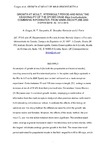| dc.contributor.author | Corgos López-Prado, Antonio | |
| dc.contributor.author | Sampedro Pastor, María Paz | |
| dc.contributor.author | González-Gurriarán, Eduardo | |
| dc.contributor.author | Freire, Juan | |
| dc.date.accessioned | 2005-10-28T11:13:06Z | |
| dc.date.available | 2005-10-28T11:13:06Z | |
| dc.date.issued | 2005 | |
| dc.identifier.uri | http://hdl.handle.net/2183/133 | |
| dc.description.abstract | [Abstract] An analysis of growth at moult (for both the prepubertal and terminal moults), moulting seasonality and the intermoult period in the spider crab Maja squinado in the Ría de A Coruña (NW Spain) was carried out based on a mark-recapture
experiment. Crabs between 70 and 130 mm carapace length (CL) undergo a mean
increase at moult of 32.4% from their pre-moult size. Generalised Linear Models
(GLMs) were used to construct growth models, employing a combination of
information from the mark-recapture study and other previous studies performed in
both laboratory and extensive culture, to estimate the effects of the biological
variables and the study method. No differences were found in the growth rate
between males and females. However, the effects of the study method, the premoult
CL and the interaction between them were significant. The smallest-sized
crabs undergo a greater increase in size in the laboratory and culture studies, while
the largest individuals undergo greater growth in the field. The mean intermoult
period estimated for prepubertal moults in the field ranged from 50 to 86 days, which
Corgos et al., GROWTH AT MOULT OF MAJA BRACHYDACTYLA
is similar to the 84.7 days observed in the laboratory study. The prepubertal moults
occurred primarily in spring and autumn in the field, while under culture conditions,
the crabs moulted mainly in the spring. The intermoult period for terminal moults was
estimated to be around 90 days, slightly lower than the value of 104 days obtained in
the laboratory. The terminal moult took place generally in summer (June-September)
both at sea as well as in culture experiments. The intermoult period of juveniles at
sea was highly variable, and some of the specimens did not moult for more than 5
months. | es_ES |
| dc.description.sponsorship | Ministerio de Ciencia y Tecnología; REN2000-0446MAR | |
| dc.description.sponsorship | Xunta de Galicia; XUGA10301B97 | |
| dc.format.mimetype | application/pdf | |
| dc.format.mimetype | text/plain | |
| dc.language.iso | eng | es_ES |
| dc.title | Growth at moulth, intermoult period and moulting seasonality of the spider crab "Maja brachydactyla" : combining information from mark-recapture and experimental studies | es_ES |
| dc.type | info:eu-repo/semantics/workingPaper | es_ES |
| dc.rights.access | info:eu-repo/semantics/openAccess | es_ES |






